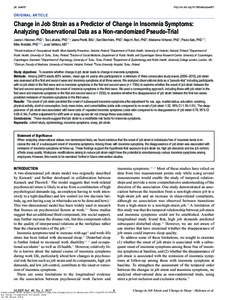| dc.contributor.author | Jussi Vahtera | |
| dc.contributor.author | Sari Stenholm | |
| dc.contributor.author | Marianna Virtanen | |
| dc.contributor.author | Jaana Pentti | |
| dc.contributor.author | Naja H. Rod | |
| dc.contributor.author | Tea Lallukka | |
| dc.contributor.author | Mika Kivimäki | |
| dc.contributor.author | Paula Salo | |
| dc.contributor.author | Jaana I. Halonen | |
| dc.date.accessioned | 2022-10-28T13:52:57Z | |
| dc.date.available | 2022-10-28T13:52:57Z | |
| dc.identifier.uri | https://www.utupub.fi/handle/10024/168036 | |
| dc.description.abstract | <p>Study objectives: To examine whether change in job strain leads to change in insomnia symptoms.</p><p>Methods: Among 24873 adults (82% women, mean age 44 years) who participated in a minimum of three consecutive study waves (2000–2012), job strain was assessed at the first and second wave and insomnia symptoms at all three waves. We analyzed observational data as a “pseudo-trial” including participants with no job strain in the first wave and no insomnia symptoms in the first and second wave (n = 7354) to examine whether the onset of job strain between the first and second waves predicted the onset of insomnia symptoms in the third wave. We used a corresponding approach, including those with job strain in the first wave and insomnia symptoms in the first and second wave (n = 2332), to examine whether the disappearance of job strain between the first two waves predicted remission of insomnia symptoms in the third wave.</p><p>Results: The onset of job strain predicted the onset of subsequent insomnia symptoms after adjustment for sex, age, marital status, education, smoking, physical activity, alcohol consumption, body mass index, and comorbidities (odds ratio compared to no onset of job strain 1.32, 95% CI 1.16–1.51). The disappearance of job strain was associated with lower odds of repeated insomnia symptoms (odds ratio compared to no disappearance of job strain 0.78, 95% CI 0.65–0.94). Further adjustment for shift work or sleep apnea did not change these associations.</p><p>Conclusions: These results suggest that job strain is a modifiable risk factor for insomnia symptoms.<br /><br /></p> | |
| dc.language.iso | en | |
| dc.publisher | Oxford Academic | |
| dc.title | Change in Job Strain as A Predictor of Change in Insomnia Symptoms: Analyzing Observational Data as A Non-randomized Pseudo-Trial | |
| dc.identifier.url | https://academic.oup.com/sleep/article/40/1/zsw007/2706414 | |
| dc.identifier.urn | URN:NBN:fi-fe2021042715926 | |
| dc.relation.volume | 40 | |
| dc.contributor.organization | fi=kansanterveystiede|en=Public Health| | |
| dc.contributor.organization | fi=psykologia|en=Psychology| | |
| dc.contributor.organization-code | 2603103 | |
| dc.contributor.organization-code | 2607307 | |
| dc.converis.publication-id | 17849551 | |
| dc.converis.url | https://research.utu.fi/converis/portal/Publication/17849551 | |
| dc.identifier.eissn | 1550-9109 | |
| dc.identifier.jour-issn | 0161-8105 | |
| dc.okm.affiliatedauthor | Vahtera, Jussi | |
| dc.okm.affiliatedauthor | Salo, Paula | |
| dc.okm.affiliatedauthor | Stenholm, Sari | |
| dc.okm.discipline | 3142 Kansanterveystiede, ympäristö ja työterveys | fi_FI |
| dc.okm.discipline | 3142 Public health care science, environmental and occupational health | en_GB |
| dc.okm.internationalcopublication | international co-publication | |
| dc.okm.internationality | International publication | |
| dc.okm.type | Journal article | |
| dc.publisher.country | Britannia | fi_FI |
| dc.publisher.country | United Kingdom | en_GB |
| dc.publisher.country-code | GB | |
| dc.publisher.place | Oxford | |
| dc.relation.doi | 10.1093/sleep/zsw007 | |
| dc.relation.ispartofjournal | Sleep | |
| dc.relation.issue | 1 | |
| dc.year.issued | 2017 | |
